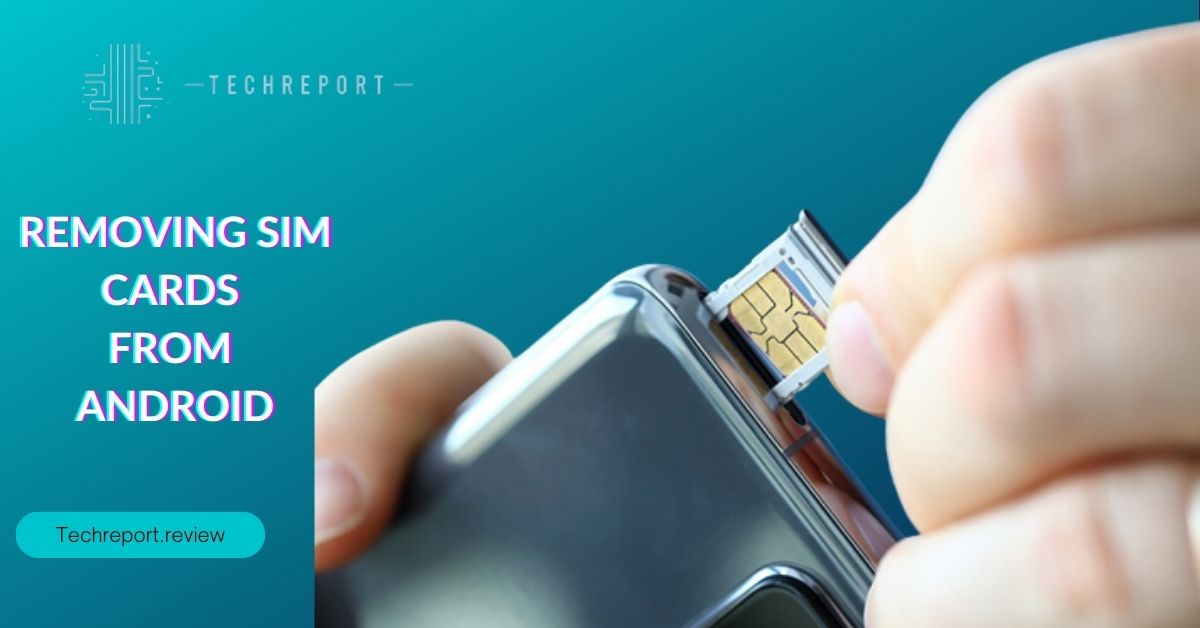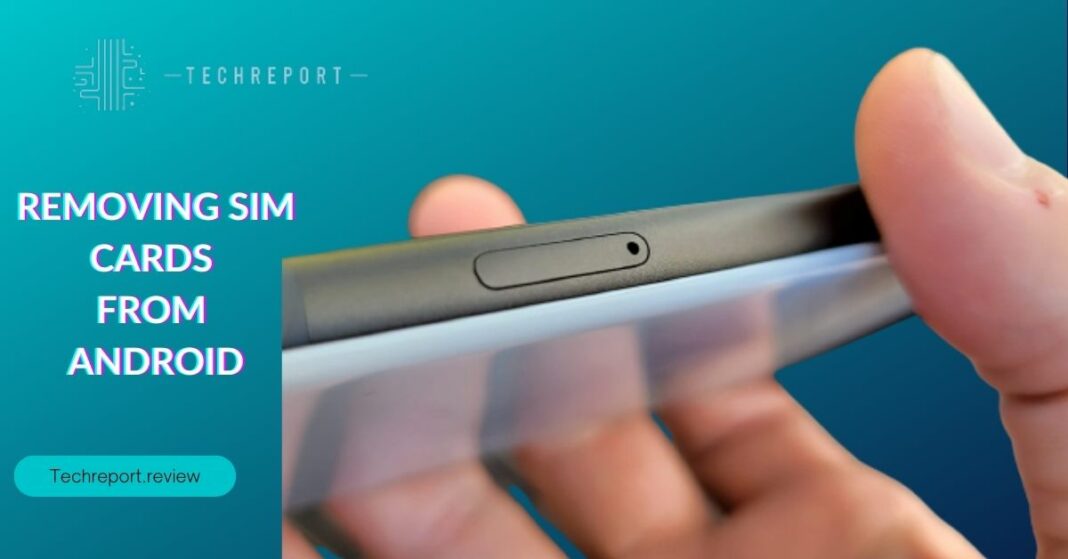In the modern digital landscape, smartphones have evolved into indispensable extensions of our lives. These pocket-sized devices seamlessly connect us to a world of information, communication, and entertainment.
At the heart of this connectivity lies the SIM card, a small yet powerful component that enables our devices to access cellular networks and stay in touch with the world.
As Android smartphones continue to dominate the market, understanding how to interact with their essential components is crucial. Among these interactions, knowing how to safely remove a SIM card from your Android device ranks high on the list.
Whether you’re upgrading to a new phone, switching carriers, or need to perform maintenance, this skill ensures that you can confidently manage your device’s connectivity without unnecessary stress or complications.
In this guide, we embark on a journey that demystifies the process of removing a SIM card from your Android phone. We’ll unravel the intricacies of SIM cards and their role within Android devices.
From a step-by-step guide to safely removing the card, addressing common concerns, and ensuring data safety, we’ll equip you with the knowledge and expertise needed to navigate this task effortlessly.
While the task might seem straightforward, it’s essential to approach it with the right knowledge and technique to prevent any mishaps that could impact both your device and your data.
By the end of this guide, you’ll possess the confidence to manage your Android SIM card like a seasoned pro, ensuring that your connectivity remains uninterrupted, your data stays secure, and your smartphone experience remains as seamless as ever.
Let’s dive into the realm of SIM card removal from Android devices and unlock the gateway to effortless connectivity management.
Unveiling the Basics of SIM Cards and Android Phones

In the world of modern communication, the unassuming SIM card plays a pivotal role, acting as the bridge between your Android device and cellular networks.
This chapter delves into the fundamental concepts of SIM cards and their seamless integration with Android smartphones, providing you with a solid foundation to understand their significance.
At its core, a Subscriber Identity Module (SIM) card is a small, fingernail-sized chip that carries a wealth of information and functions.
This tiny marvel holds the key to establishing your device’s identity on cellular networks. It’s this identity that allows you to make calls, send texts, and access data services. Think of it as your smartphone’s personal ID card for the digital world.
When you insert a SIM card into your Android device, you’re essentially giving it an identity. This identity is tied to your phone number, unique network codes, and other crucial data.
This enables your device to authenticate itself on a cellular network, allowing you to communicate with other devices, access the internet, and engage in a range of mobile activities.
Beyond identity, a SIM card stores essential information like contacts, text messages, and even some network-specific settings. This ensures that you can switch devices without losing your contacts or text history.
Furthermore, it plays a pivotal role in enabling your device to communicate with cellular towers and connect to the wider network infrastructure.
The Android operating system has revolutionized the smartphone landscape, powering a diverse array of devices that cater to various needs and preferences.
With its open-source nature and user-friendly interface, Android has captured a significant share of the smartphone market.
Android smartphones are ubiquitous, found in the hands of people from all walks of life. From flagship models with cutting-edge features to budget-friendly options, Android devices cater to a vast audience with diverse needs.
This widespread use showcases Android’s adaptability and its ability to provide a personalized experience for every user.
The integration of SIM cards in Android devices is seamless and intuitive. Most Android phones have a designated slot or tray specifically designed to accommodate SIM cards. This physical integration allows users to easily insert, remove, and manage their SIM cards without complicated procedures.
As you journey through this chapter, you’ll gain a deeper understanding of the symbiotic relationship between SIM cards and Android smartphones.
This foundation will serve as the basis for the practical knowledge you’ll acquire in the subsequent chapters, ensuring that you’re well-equipped to manage your device’s connectivity with confidence.
The Step-by-Step Guide to Removing a SIM Card from Android
In this chapter, we embark on a hands-on journey that guides you through the process of removing a SIM card from your Android device.
Whether you’re upgrading, switching devices, or simply need to access your SIM card, these step-by-step instructions will ensure that you perform the task with confidence and precision.
Before you embark on the process of removing your SIM card, it’s essential to ensure that you have the necessary tools at hand. While different Android models might have variations in the tools required, having a SIM card removal tool is highly recommended.
If this tool isn’t available, alternatives like paperclips or even earring backings can serve the purpose.
A SIM card removal tool is a small pin-like instrument that aids in safely ejecting the SIM card tray from your device. It’s specifically designed to fit into the tiny hole on the SIM card tray, ensuring that you can remove it without causing any damage.
Having this tool or suitable alternatives is crucial to perform the task efficiently and without unnecessary complications.
Before you delve into the process of removing the SIM card, it’s imperative to power off your Android device. This seemingly simple step holds significant importance, as it minimizes the risk of potential data loss or damage during the removal process.
Powering off your device creates a safe environment for SIM card removal. It prevents any active processes from interfering with the task, ensuring that the card can be removed without any electronic activity posing a risk.
Powering off your device before removing the SIM card safeguards your data and the device itself. It prevents potential disruptions that could lead to data corruption or hardware damage.
By taking this precautionary measure, you’re setting the stage for a smooth and risk-free SIM card removal process.
Now that you’re equipped with the essential tools and have powered off your device, it’s time to locate the SIM card tray. While this might seem straightforward, different Android models have varying placements for the SIM card tray.
The SIM card tray’s location can vary between the top, side, or even bottom of the device, depending on the manufacturer and model. Providing guidance on how to identify this tray based on your specific Android model ensures that you’re ready for the next step.
To enhance your understanding, we’ve included visual aids showcasing the SIM card tray’s location on popular Android devices. These visuals serve as valuable references, allowing you to pinpoint the tray’s location accurately.
By the end of this chapter, you’ll have the necessary knowledge to initiate the SIM card removal process confidently. Armed with a clear understanding of the tools required, the importance of powering off your device, and the ability to locate the SIM card tray, you’re well on your way to mastering this crucial aspect of Android device management.
Addressing Common Concerns and Providing Expert Tips
As you embark on the journey of removing a SIM card from your Android device, certain concerns and challenges might arise.
This chapter is designed to address those common concerns and provide you with expert tips that will help you navigate potential hurdles with ease and confidence.
Your SIM card is a delicate piece of technology, and handling it with care is crucial to maintaining its functionality. Here, we offer insights into best practices to ensure that your SIM card remains unscathed during the removal process.
Handle the SIM card with clean, dry hands. Avoid touching the gold contacts on the card to prevent the transfer of oils and dirt, which could interfere with its performance.
While the SIM card might appear sturdy, its delicate components are susceptible to bending and scratching. Avoid any forceful bending or rough handling. Use gentle movements when inserting or removing the card to minimize the risk of damage.
In some instances, your SIM card might be reluctant to part ways with its slot. When faced with a stuck SIM card, knowing how to address this situation is essential to prevent frustration and potential damage.
If you encounter resistance while trying to remove the SIM card, refrain from using excessive force. Applying force could lead to damage. Instead, proceed with caution and explore alternative approaches.
Try gently shaking the device to encourage the SIM card to dislodge. If this doesn’t work, consider using a paperclip or similar tool to carefully pry the card free. Always prioritize caution to avoid any accidental damage.
Android smartphones come in a variety of models, each with its own design and features. Understanding how SIM card removal methods can vary between these models is essential for a smooth experience.
Different Android models have distinct placements and mechanisms for the SIM card tray. It’s important to recognize that the process might vary based on whether your device is from Samsung, Google Pixel, LG, or any other manufacturer.
To cater to the diverse Android landscape, we provide guidelines on how to adapt the removal process to specific manufacturers. This ensures that you can confidently apply the instructions to your device, regardless of its brand.
By exploring these common concerns and expert tips, you’re equipped with the knowledge to handle potential challenges effectively. As you navigate the SIM card removal process, remember that patience and caution are your allies.
These insights will empower you to overcome any obstacles and complete the task with the confidence of an Android connectivity enthusiast.
In Crux
As we conclude this comprehensive guide, you’ve embarked on a journey that demystified the process of removing a SIM card from your Android device.
Armed with knowledge, insights, and practical instructions, you’ve taken significant strides in mastering this essential skill that ensures seamless device management.
The ability to confidently remove a SIM card from your Android phone is more than just a practical skill; it’s a testament to your understanding of the intricate relationship between technology and human interaction.
By understanding the role of a SIM card, the significance of powering off your device, and the steps required for safe removal, you’ve shown a willingness to engage with your device at a deeper level.
Addressing common concerns, such as preventing damage to the SIM card or dealing with stuck cards, demonstrates your ability to adapt and troubleshoot in real-world scenarios.
Your newfound expertise empowers you to face challenges with a sense of confidence, knowing that you have the tools to handle them effectively.
The Android landscape is rich with diversity, and this guide has equipped you with the understanding to adapt the SIM card removal process to various manufacturers and models.
Whether you’re using a Samsung, Google Pixel, LG, or any other Android device, your proficiency transcends brand boundaries.
The world of technology thrives on continuous learning and exploration. By mastering the art of SIM card removal, you’ve taken a step toward a deeper engagement with your Android device.
You’ve embraced the empowerment that comes from understanding the inner workings of a component that plays a pivotal role in your daily connectivity.
As you reflect on the knowledge you’ve gained, remember that it’s not just about removing a physical card; it’s about embracing the essence of connectivity that defines our digital age.
The SIM card is a symbol of your link to the digital world, and your ability to manage it effectively adds a layer of control and confidence to your tech-savvy journey.
With this guide as your companion, you’re well-prepared to confidently manage your Android’s connectivity. The art of SIM card removal is now a part of your tech toolkit, a skill you can carry forward as you continue to explore and engage with the ever-evolving landscape of technology.
Congratulations on mastering this fundamental task, and may your journey in the world of Android devices be both seamless and enriching.
How much did you like our detailed SIMply Seamless: Your Expert Guide to Removing SIM Cards from Android. Please share these Blogs with your friends on social media.
Related Blogs
- Is iPhone 14 Worth the Hype
- iPhone 15 Pro
- Apple CarPlay
- Apple Watch
- iPhone 6 vs Nexus 6
- Apple Vision Pro
FAQs about Removing SIM Cards from Android
Can I damage my phone by removing the SIM card incorrectly?
While removing a SIM card is a straightforward process, mishandling could potentially lead to damage. Applying excessive force or inserting foreign objects into the SIM card slot might harm the device or the card. To avoid this, always use the correct tools and follow the recommended steps for removal. Power off the device, use a proper SIM card removal tool and handle the SIM card with care.
What should I do if my SIM card is stuck?
If your SIM card is stuck, avoid using force, as it can damage both the card and the device. Try gently shaking the device to encourage the card to loosen. If this doesn't work, use a paperclip or a similar tool to carefully dislodge the card. Prioritize caution and patience to prevent any accidental damage during the process.
Is there a risk of data loss when removing the SIM card?
Powering off your Android device before removing the SIM card significantly reduces the risk of data loss. While the SIM card doesn't store personal data like photos or apps, it might contain contacts and text messages. Powering off prevents active processes that could lead to data corruption. However, it's still a good practice to back up your data before performing any hardware changes.
Can I remove the SIM card while my Android phone is turned on?
It's advisable to power off your Android phone before removing the SIM card. This prevents active processes from interfering with the removal process and ensures that the card can be safely ejected without any complications. Powering off your device adds an extra layer of protection to both the device and the SIM card.
Are the SIM card removal methods the same for all Android models?
SIM card removal methods can vary between Android models due to differences in the design and placement of the SIM card tray. Various manufacturers like Samsung, Google Pixel, and LG might have distinct tray locations. Always refer to your device's manual or online resources specific to your model for accurate instructions.
How can I prevent damage to the SIM card during removal?
To prevent damage to the SIM card, handle it with clean, dry hands. Avoid touching the gold contacts to prevent the transfer of oils or dirt. Use gentle movements when inserting or removing the card to prevent bending or scratching. Employing care and caution ensures that the delicate components of the SIM card remain intact.
What if I accidentally damage my SIM card while removing it?
Accidental damage to the SIM card can occur, but it's important not to panic. If the card is physically damaged, it might need replacement. Contact your carrier to obtain a new SIM card. Remember to follow proper handling procedures when inserting the new card to avoid further complications.
Can I adapt the removal process for specific Android manufacturers?
Absolutely. Different Android manufacturers have variations in SIM card tray placement and mechanisms. For instance, Samsung, Google Pixel, and LG might have different removal processes. Always consult manufacturer-specific resources for accurate guidance tailored to your device.
Can I reuse my SIM card if I change devices?
In most cases, you can reuse your SIM card if you're switching devices within the same carrier. However, if you're switching carriers or your new device requires a different SIM card size, you might need a new SIM card. Before making any changes, it's wise to contact your carrier to ensure a seamless transition.
























